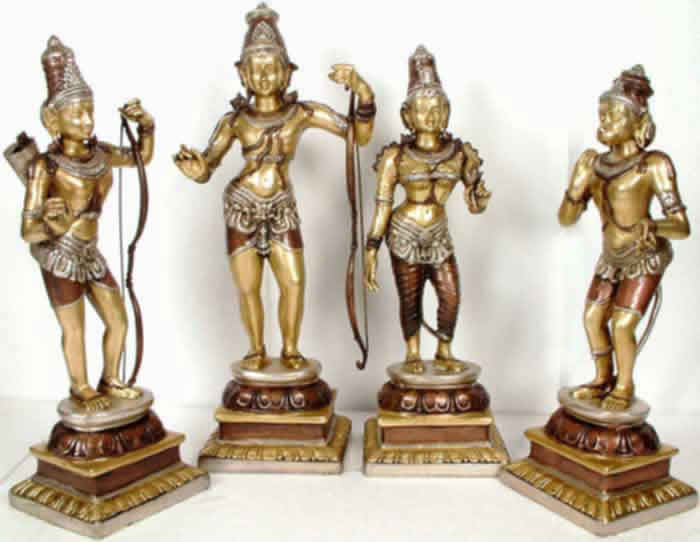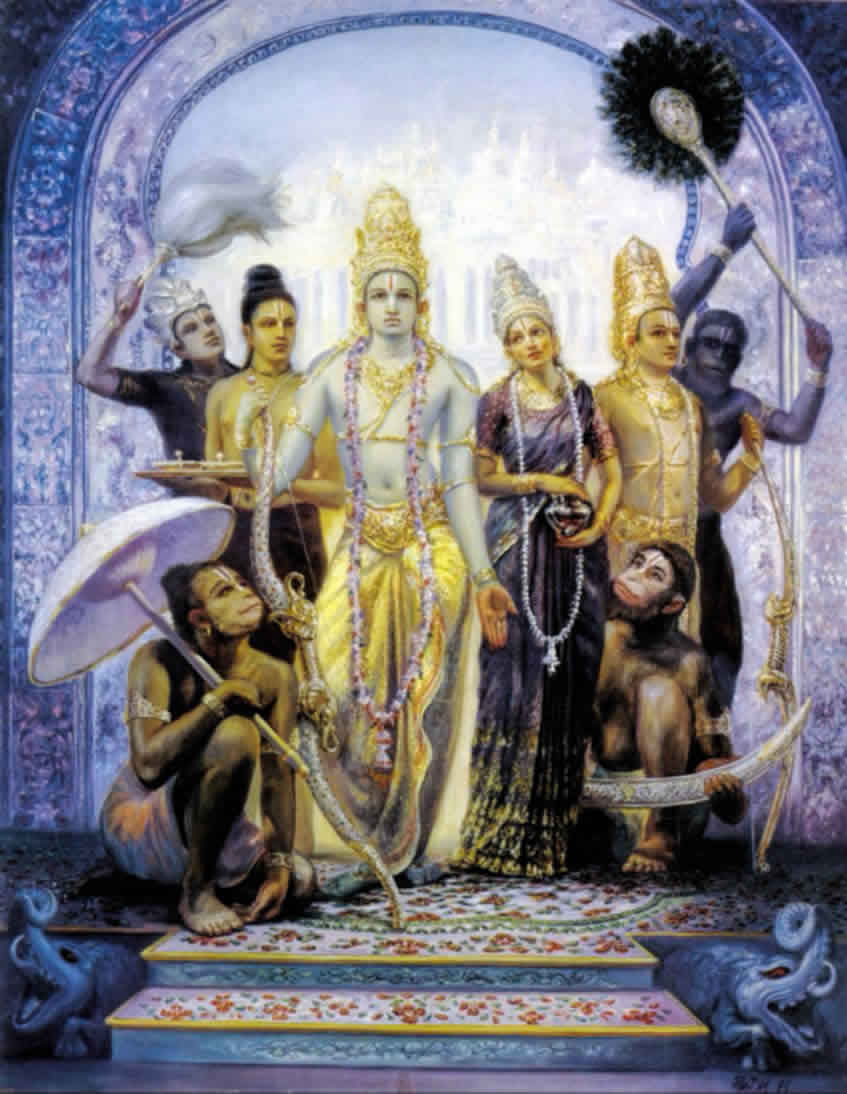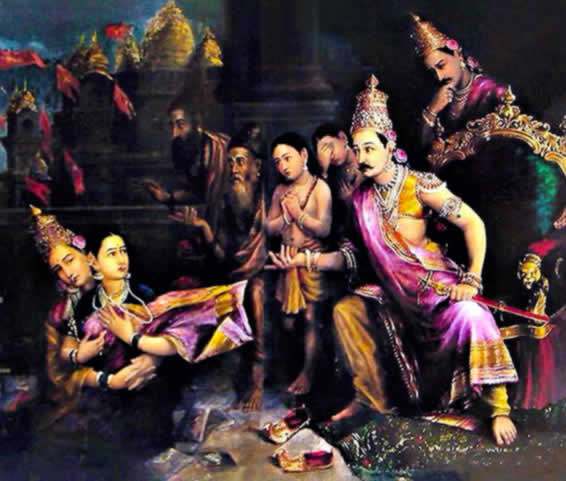Is “Sri Lanka” the “Lanka”
of the Ramayana?
Shyamasundara Dasa
Copyright © 2016
(Revised April 2, 2025)
"A brahmana sees through the sastras. A king sees through his spies. A cow sees through its nose. (to detect eatables) And, an ordinary man sees through his eyes." Canakya Pandit
The Ramayana is one of the two main itihasa - historical epics – of India, along with the Mahabharata. It describes the activities of Krsna’s incarnation Lord Rama, including the kidnapping of His consort Sita by Ravana, King of Lanka, and the subsequent military campaign to release her. Since a substantial amount of the history takes place in Lanka the actual real identity of Lanka is important to Vaisnavas and devotees of Lord Rama in general. For hundreds, perhaps thousands of years the island that is currently known as “Sri Lanka” has traditionally been identified as the “Lanka” of the Ramayana. But is this really the case? Does the Ramayana support this tradition? This short article explores other possibilities that are consistent with the text of the Ramayana. Strict followers of Krsna’s Vedic culture accept sabdha brahma – knowledge revealed by God (the Ramayana) – as the highest evidence, superior to all others, including tradition.
What do the Sastras Say
About the Real Lanka?
Until 1972 “Sri Lanka” was called Ceylon, which is derived from Tamil Ceralamdivu, Sanskrit Simhaladvipa and Persian Sarandīp. For more information on the former names of Ceylon click on this link and this link.
Siṁhala and Laṅkā
The majority population of what is now known as “Sri Lanka” are called the Sinhalese people after an old name for the island “Siṁhala.” This name is attested in the Śrīmad-Bhāgavatam 5.19.29-30:
Śrī Śukadeva Gosvāmī said: My dear King, in the opinion of some learned scholars, eight smaller islands surround Jambūdvīpa. When the sons of Mahārāja Sagara were searching all over the world for their lost horse, they dug up the earth, and in this way eight adjoining islands came into existence. The names of these islands are Svarṇaprastha, Candraśukla, Āvartana, Ramaṇaka, Mandara-hariṇa, Pāñcajanya, Siṁhala and Laṅkā.
However Siṁhala cannot be Laṅkā because “Laṅkā” is listed as the name of a separate and different island.
-
You may also be interested in:
- Well, It’s a Crazy Story
- Ashtamangala Deva Prashna
- Are There Different Sizes of Infinity?
- On Inspiration
- Life of Govinda Bhattathiri, ]yotisha Acarya
Distance
"Ceylon - Sri Lanka" is less than 100 km (62 miles) from India whereas in the Valmiki Ramayana1 it specifically says that the real Lanka was a distance 100 yojanas across the ocean.
“On a well-known island in the sea, situated at a distance of full one hundred yojanas from this shore, lies the lovely city of Lanka, constructed by Viswakarma, (the architect of gods), abounding in wonderful gates of Jambunada (gold found on the banks of the Jammu river) and stately mansions of golden hue with terraces of gold and enclosed by a massive fortification wall bright as the sun.” Valmiki Ramayana Kiskindhakanda 58.20
Revision, May 17, 2016
1 yojana = 12.5 km, 100 yojanas = 1250 km (776 miles)2
Thus, Lanka was at least 1250 km off shore. This distance of 100 yojanas is mentioned many times in the Ramayana as the distance a person would have to cross to get to Lanka.
Not only was the bridge 100 yojanas long in order to reach Lanka, but according to Valmiki Ramayana Yuddhakandha 22.76 it was also 10 yojanas wide (125 km=77 miles). Thus just the width of the bridge was more than the current distance from India to Ceylon, modern "Sri Lanka."
Surya-siddhanta
And, Lanka was about 500 km to the west of Ceylon. Why? Because in the Surya-siddhanta the prime meridian3 is the one going through Avanti (Ujjain). And, it explicitly states that the prime meridian went through both Avanti and through “the haunt of the rakshasa”, that is, Lanka, the kingdom of the king of the rakshasas, Ravana, as well as other places.
“Situated upon the line which passes through the haunt of the demons (rakshasa) and the mountain which is the seat of the gods, are Rohitaka and Avanti, as also the adjacent lake.” Suryasiddhanta 1.62 4
And, in the Siddhantas “Lanka” is taken to be the place with no longitude and latitude.5 No longitude is because it is the prime meridian and no latitude is because Lanka is on the equator, whereas Ceylon is about 7 degrees north of the equator.
Now lets take a look at a map to see what this gives us. (The black line is the prime meridian going through Avanti, and the red line is the equator.)

We don’t see much at the intersection point of the meridian of Avanti and the equator in the Indian Ocean. Now let’s take another look using a bathymetric map that shows the topography of the ocean floor.

Now we see that close to the place where Lanka is supposed to be is a ridge of underwater mountains some of which stick up as the Maldives Islands.
Ice Ages and Changing Sea Level
Now it is time to take in another piece of evidence regarding the variations in sea level caused by ice ages. Scientists have discovered that there have been several major ice ages in the distant past. During an “ice age” large areas of the land surface (30% in the last glaciation) get covered with massive sheets of ice 3 km thick. The water for this ice comes largely from the oceans causing a drop in the sea level. It is estimated that the maximum drop in the sea level during the last glaciation was about 130m. In other glaciations the drop in sea level is not known, it could be more or less.
The current ice age that we are in is the Quaternary glaciation, also known as the Pleistocene glaciation, and refers to a series of glacial events separated by interglacial events during the Quaternary period from 2.58 million years ago to present. We are now in an “interglacial period” meaning a warm period in the ice age. Ice ages are a series of long periods (40,000 – 100,000 years) of glacier formation followed by a short period of thawing then another long period of glacier formation.
This diagram shows the changing sea level at different points in time.
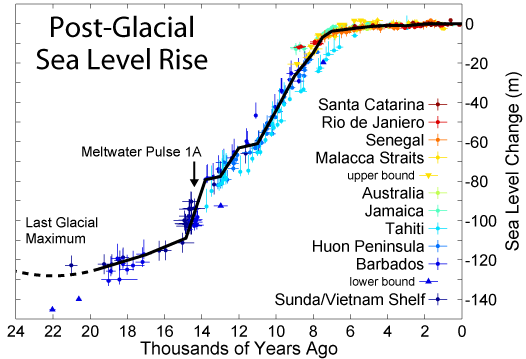
We note that 20,000 years ago the sea level was about 130 meters lower than it is today. Though 20,000 years is a long time the events in the Ramayana took place at the end of the Treta-yuga of the 24th maha-yuga cycle about 18,144,000 years ago. 6 Since historically there have been rising and falling of the sea level. And currently there is concern that the sea level will rise even more because of global warming, flooding low-lying areas. It is therefore not unreasonable to infer that such cyclic rising and falling of the sea level also took place in the distant past as a natural phenomenon, like the changes in the seasons that also took place in the past. Because as Krsna explains in Bhagavad-gita 8.4 “Physical nature is known to be endlessly mutable.” Hence it is not unreasonable to infer that the sea level would also be subjected to periods of rising and falling throughout the history of the material creation including the time during and after the Ramayana.
Now lets take a look at another bathymetric map, this time showing additional areas that would be above water if the sea level had fallen 130 meters +/- 10 meters.
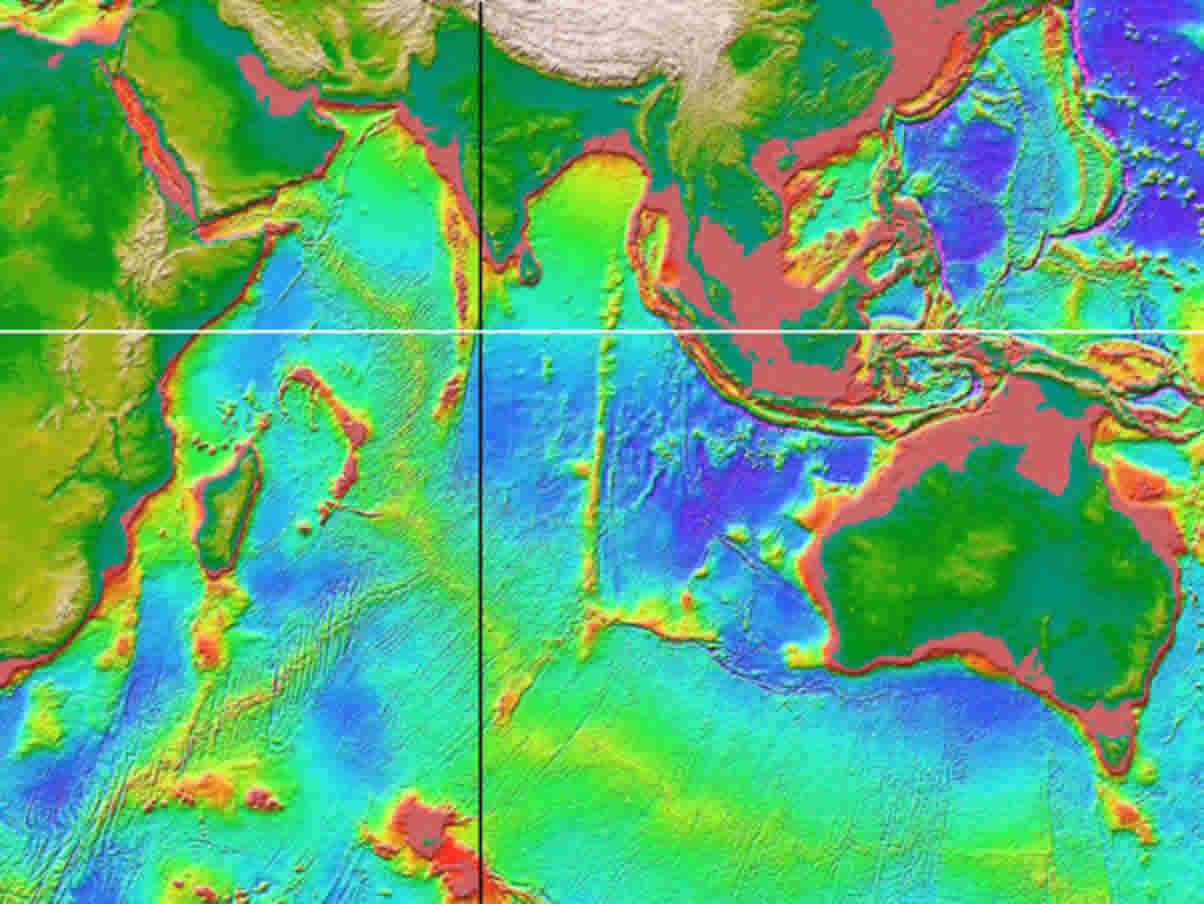
In this map the red and dark pink parts would have been dry land during the last glaciation because of the drop in sea level. The first thing to notice is that Ceylon - "Sri Lanka" is not an island but actually part of the Indian landmass. That definitely rules out Ceylon from being Lanka. Next we notice that very close to where the prime meridian of Avanti crosses the equator is a large island. So this strongly suggests that in the distant past an island existed in the location where the Ramayana and Suryasiddhanta said Lanka would be if the events of the Ramayana took place during a period of glaciation with a much lower sea level. This island is certainly very much closer to the intersection of the prime meridian and the equator than Ceylon - "Sri Lanka" is.
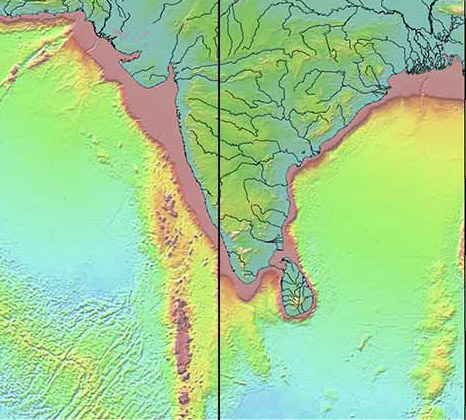
Above is close up view showing more clearly how Ceylon was part of the Indian sub-continent. The vertical line is the meridian of Avanti while the bottom of the image corresponds to the equator.
Volcanic activity
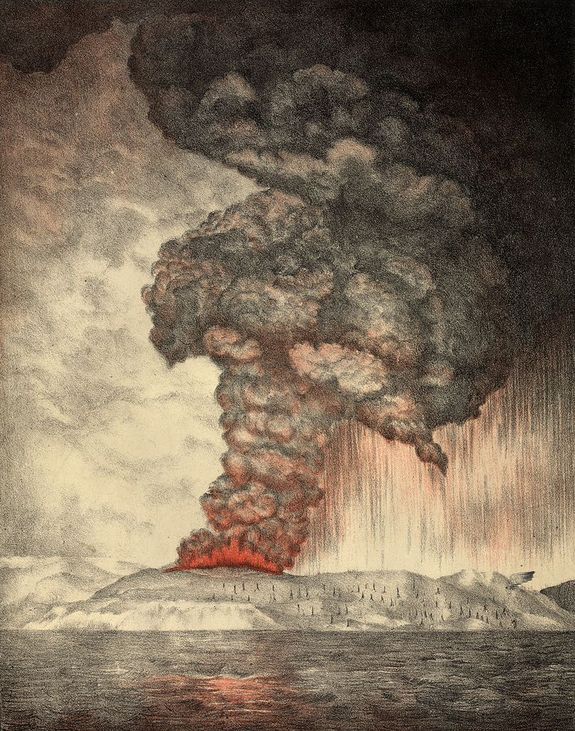
A lithograph depicting the eruption of Krakatoa
Aside from changing sea levels there are many historical incidents of islands disappearing because of volcanic activity. One of the most spectacular in recent history was the destruction of Krakatoa on August 27, 1883. Four tremendous explosions, heard as far away as Perth, Australia, some 2,800 miles (4,500 km) hurled an estimated 11 cubic miles (45 cubic km) of debris 15 miles (24 km) into the air darkening skies up to 275 miles (442 km) from the volcano. The eruption is estimated to have had the explosive force of 200 megatons of TNT. For purposes of comparison, the bomb that devastated Hiroshima had a force of 20 kilotons (1000 kilotons = 1 megaton). Loss of life is estimated to have been between 36,000 - 120,000. When it was all over only water remained where there was once an island.
Objections
How can you say that "Sri Lanka" is not the Lanka of the Ramayana when there are so many temples and pilgrimage sites in "Sri Lanka" and in India near Rameshwaram where the pastimes mentioned in the Ramayana took place and that are visited by millions of pilgrims yearly. Surely they all can't be wrong.
In reply to this I would just like to point out that Lord Caitanya Mahaprabhu appeared relatively recently in 1486, 530 years ago. His birth place was on the banks of the Ganga. Within a short period of time after His departure the channel of the Ganga changed its course and His birthplace was lost and covered in water. The Ganga changed its course several times and memory of His actual birthplace was lost. But this didn't stop people from building temples and claiming that a different city was the birth place of Lord Caitanya and millions of people believed that to be true until Bhaktivinode Thakura with great dectective work was able to find the actual site of Mahaprabhu's appearance. So if in only a few hundred years so much confusion arose in regards to Lord Caitanya’s actual place of birth, what to speak then of what confusion can happen in the interval since the end of the Treta Yuga of the 24th maha-yuga cycle more than 18,144,000 years ago.
Another point is that Ceylon was then part of the mainland and Lord Rama would certainly have traversed that area as well as other parts of extreme South India, so they indeed are connected to the Rama lila depicted in the Ramayana but that does not mean that “Sri Lanka” is the Lanka of the Ramayana.
Another objection is that according to the theory of the tectonic shift of continental plates, that over the course of 18,144,000 years Lanka could have moved 1250km (776 miles) from its original position to where Ceylon/Sri Lanka is currently located.
In response we note that according to this theory, Sri Lanka is considered to be a part of the larger Indo - Australian plate and thus does not move independently. This means that it always in the same relative position to the Indian sub-continent. Britannica
Great Acaryas do not Accept the Modern
“Sri Lanka” to be the Lanka of Ramayana.
In the following letter from Tamala Krsna Goswami, Srila Prabhupada’s secretary, to Hansadutta Swami, he refers to ongoing research that they are doing under Srila Prabhupada’s supervision. And that during the course of their investigation the discrepancy regarding the identity of Lanka was discussed and that Srila Prabhupada concluded that the modern "Sri Lanka" was not Ravana's Lanka of the Ramayana.
“It may be interesting to know that one sannyasi here, Bhakti Prem Swami, who is a Sanskrit expert, as well and Yasodanandan Swami and myself are working under Srila Prabhupada's direction on chalking out the model for the planetarium. One interesting fact is that in the Fifth Canto, Chapter 19, Text 30, the names of the islands of Bharata-varsa are given. The island of Sri Lanka which you are currently on is mentioned there as Simhala and Lanka where Ravana's empire was is mentioned. But this Lanka actually is 800 miles to the west 7 of India, as stated in the Ramayana. So Sri Lanka is not the Lanka of Ravana. When Srila Prabhupada heard this, he laughed and said that this is another one of the misconceptions of the scientists smashed.” Letter to Hansadutta -Vrndavana, June 25, 1977
Revision, April 16, 2016.
The letter above by Tamala Krsna Gosvami where he states that Lanka is not Ceylon is a succinct description of room conversations with Srila Prabhupada such as this one several days earlier. We note in the conversation that Srila Prabhupada states that it is not our job to satisfy the scientists but rather to give the sastric conclusion. One of those conclusions is that Ceylon is not Lanka:
Bhakti-prema: So how we will expose it before scientists?
Prabhupada: We do not require to satisfy the scientists. We have to describe according to our book. That's all. If they can understand, let them understand. Otherwise... It is not our business to satisfy the so-called scientists. We are giving the real description. [break] That Sokimala.[?] [break] [indistinct]
Upendra: Not like that, no. There have been some clouds.
Prabhupada: Something in the sea turns right, and the whole thing becomes [indistinct]. [break]
Tamala Krsna: ...the original Lanka. Ceylon, of course, is there, but it is not Lanka.
Prabhupada: Ceylon is different.
Tamala Krsna: Yes. Who knows what else we will discover today. These things... When we are actually...
Prabhupada: The Andaman, Nicobar Islands...
Tamala Krsna: What did you say, Srila Prabhupada?
Prabhupada: There are other islands.
Tamala Krsna: Yes.
Prabhupada: Andaman, Nicobar, like that.
Tamala Krsna: Oh. But we're not... Bhakti-prema Maharaja said that yesterday... He was going to look through the commentaries to try and understand which these referred to in present-day's, you know, geography. He wasn't certain about. He only knew that one was...
Prabhupada: There are nearby islands. I don't know whether it is... Andaman, Nicobar Islands. So those islands similarly from India were sent. Now it is inhabited. [break] ...work is stopped on account of your [indistinct]?
>>> Ref. VedaBase => Room Conversation -- June 18, 1977, Vrndavana
Anyone who objects must in turn be able to give a credible answer to the question of why "Sri Lanka-Ceylon" is not found where the sastras say Lanka should be? At least 100 yojanas (1250 km) away, on or near the equator, and at the meridian passing through Avanti. What I have shown closely agrees with sastra but the location of modern "Sri Lanka-Ceylon" does not.
Reverting to our opening statement:
"A brahmana sees through the sastras.
A king sees through his spies.
A cow sees through its nose. (to detect eatables)
And, an ordinary man sees through his eyes."
Canakya Pandit
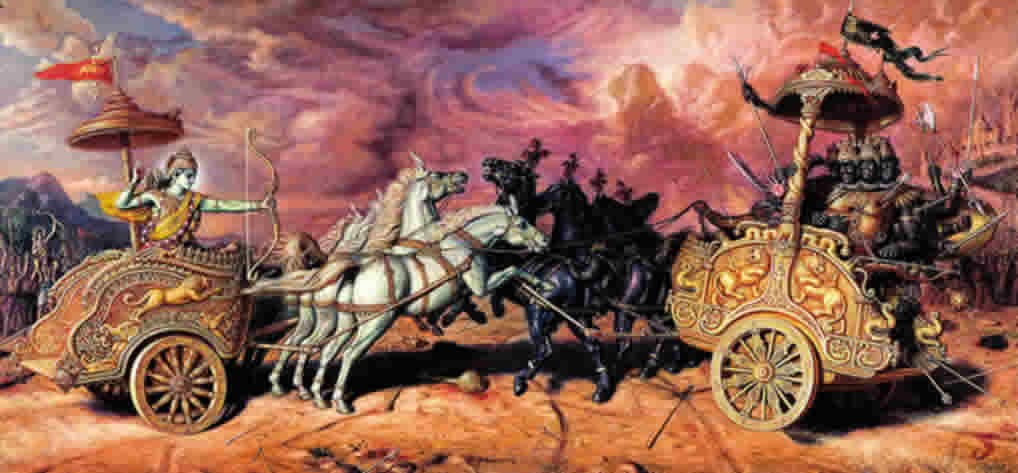
Lord Rama does battle with Ravana, King of Lanka
Conclusion
In conclusion I have thus adumbrated a basic proof of concept 8 that modern "Sri Lanka" is not the Lanka of the Ramayana on the following basis. Ceylon was only recently named "Sri Lanka" in 1972. One ancient name for the island is Simhala, and even today the people of the island call themselves and their language as Singalese in reference to that name, yet texts like Srimad Bhagavatam name Simhala and Lanka as two different islands. "Sri Lanka" is less than 100 km from India but the Valmiki Ramayana unequivocally states that Lanka was 100 yojanas (1287 km) across the sea. And, according to the Surya-siddhanta the real Lanka was located on the prime meridian passing through Avanti (Ujjain) as well as straddling the equator, whereas "Sri Lanka" is about 500 km to the east of the prime meridian and 7 degrees (430 km) north of the equator. And, that in the vicinity of the intersection of the prime meridian of Avanti and the equator where Lanka is supposed to be located is a chain of undersea mountains that currently form the Maldives Islands. However, during glaciation periods in the distant past the sea level dropped by at least 130 meters bringing the undersea mountains above the surface of the water and equally important making Ceylon part of the Indian land mass and no longer an island. (Additionally aside from rising seas the original Lanka could also have been destroyed in a massive volcanic eruption and sunk into the sea like Krakatoa.) Hence, considering the above points and that the statements of the Ramayana are considered to be the highest evidence to followers of Vedic culture therefore "Sri Lanka" is not the Lanka of the Valmiki Ramayana.
Read about other mysteries in the Ramayana. Find out The Real Reason Sita was Exiled by Rama.
Footnotes
1 We only accept the Valmiki Ramayana as the mula Ramayana and authentic and suitable to cite as pramana (epistemological proof) not others.
2 According to Varaha Mihira’s Pancasiddhantika 13.15-19 the distance from the pole to the equator is 800 yojanas. And, according to the original definition there were 10,000 kilometers from the pole to the equator. Thus 100 yojanas equal 1,250 km and 1 yojana equals 12.5 km, which is 7.767 miles or roughly 8 miles. Thus Lanka was 1,250 km south of India.
3 The prime meridian is the starting or zero point of the astronomical observational system, in modern times the meridian of Greenwich is the “Prime meridian” and Avanti (Ujjain) is 75° 46’.63 east of Greenwich.
4 See also Suryasiddhanta 1.50.
5 See Whitney’s commentary on Suryasiddhanta 1.62 -- Burgess edition.
6 In Srimad-Bhagavatam (9.10.51) it states that Ramayana took place during Treta-yuga. Treta-yuga ended about 900,000 years ago thus we might think that the Ramayana took place then. The assumption is that it was the last Treta-yuga instead of a Treta-yuga from some previous maha-yuga. But Vayu Purana (70.48) and Matsya Purana (47.245) give more details indicating that Ramayana took place in the 24th maha-yuga cycle of the current manvantara — while we are currently in the Kali-yuga of the 28th maha-yuga cycle. That would place the most recent Ramayana approximately 18,144,000 years ago.
7 He actually means 800 miles South of Lanka not West of Lanka because that is what the Ramayana states.
8 "Proof of concept" is a realization of a certain method or idea to demonstrate its feasibility, or a demonstration in principle, whose purpose is to verify that some concept or theory has the potential of being used. A proof of concept is usually small and may or may not be complete. Click for more information.
References
Burgess, Ebenezer, 1860, Sûrya-Siddhânta, A Text-Book of Hindu Astronomy; Journal of the American Oriental Society, Vol. 6 (1858 - 1860), pp. 141-498
Mihira, Varaha, 1993, Pancasiddhantika of Varaha Mihira, translation and commentary by Sastry, Kuppanna, T.S., Madras (Chennai), India: Adyar Library and Research Centre.
Valmiki, 2006, Srimad Valmiki Ramayana, translated from Sanskrit, Gorakhpur, India: Gita Press.
Further reading
Tsunami may have revealed lost city
Underwater Ruins
National Geographic: Rising Seas
Global Bathymetric Prediction for Ocean Modelling and Marine Geophysics
MEASURED AND ESTIMATED SEAFLOOR TOPOGRAPHY
Sea Level Rise, After the Ice Melted and Today
Basic Geology Part 3 – Sea Level Rises During Interglacial Periods
Meltwater pulse 1A
Ice age
Ice Ages and Sea Levels

